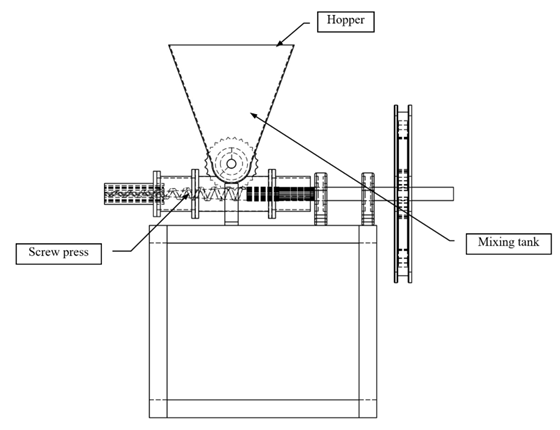Effect of feed rate and screw pressing speed to the performance of a charcoal block pressing machine
Main Article Content
Abstract
This study aimed to examine the effects of feed rate and screw pressing speed on the performance of a cassava-stump charcoal block pressing machine, as well as to design and develop a prototype. The machine consists of several components, including a mixing tank, screw conveyor, hopper, screw pressing unit, transmission system, and main frame. The experiment tested feed rates of 80, 100, and 120 kg/h and screw pressing speeds of 80, 95, 110, and 125 rpm. Results showed that the produced charcoal blocks had an average length of 13.91±1.62 cm, an outer diameter of 4.12±0.05 cm, an internal diameter of 1.23±0.12 cm, and a moisture content of 3.31% (dry basis). When tested at a screw pressing speed of 125 rpm and a feed rate of 120 kg/h, with a mixture ratio of cassava stump charcoal, cassava starch, and water at 3.00:0.45:4.00 kg, the machine achieved a production capacity of 111.7 kg/h, specific energy consumption of 13.35 w-h/kg, a bulk density of 505.3 kg/m³, a charcoal strength ranging from 82.14 to 159.51 kN/m², and a heating value of 5113.3 cal/g.
Article Details

This work is licensed under a Creative Commons Attribution-NonCommercial-NoDerivatives 4.0 International License.
References
Basu P. Chapter 7 - Gasification Theory. In: Basu P, editor. Biomass Gasification, Pyrolysis and Torrefaction (3rd Edition), Academic Press; 2018, p. 211–62. https://doi.org/10.1016/B978-0-12-812992-0.00007-8.
Kaliyan N, Morey RV. Densification characteristics of corn stover and switchgrass. Trans ASABE 2009;52:907–20. https://doi.org/10.13031/2013.27380.
Tumuluru JS, Wright CT, Hess JR, Kenney KL. A review of biomass densification systems to develop uniform feedstock commodities for bioenergy application. Biofuels, Bioproducts and Biorefining 2011;5:683–707. https://doi.org/10.1002/bbb.324.
Li Y, Liu H. High-pressure densification of wood residues to form an upgraded fuel. Biomass Bioenergy 2000;19:177–86. https://doi.org/10.1016/S0961-9534(00)00026-X.
Bergström D, Israelsson S, Öhman M, Dahlqvist S-A, Gref R, Boman C. Effects of raw material particle size distribution on the characteristics of Scots pine sawdust fuel pellets. Fuel Processing Technology 2008;89:1324–9. https://doi.org/10.1016/j.fuproc.2008.06.001.
Rahimi MJ, Sitaraman H, Sievers DA, Stickel JJ, Fakhrabadi EA, Liberatore MW. Simulations of biomass compression-screw feeding using a compressible non-Newtonian constitutive model. Chem Eng Sci 2023;281:119117. https://doi.org/10.1016/j.ces.2023.119117.
Liu D, Eksioglu S, Roni M. Optimal control of biomass feedstock processing system under uncertainty in biomass quality. IEEE Transactions on Automation Science and Engineering 2021;19:1645–61. https://doi.org/10.1109/TASE.2021.3133211
Dechphon S. Study on potential and efficiency of the mixture of briquenttes from sugar industrial sludge and bagasse. King Mongkut’s University of Technology Thonburi, 2003.
Laloon K, Sudajan S, Chusin S. An efficiency improvement on bio-coal in household industry. Agric Sci J 2008;39:461–4.
Laloon K, Sudajan S. Effects of mixing ratio between eucalyptus bark charcoal and cassava starch on the performance of a charcoal block pressing unit. Adv Mat Res 2014;931–932:1568–73. https://doi.org/10.4028/www.scientific.net/AMR.931-932.1568.
Adapa PK, Tabil LG, Schoenau GJ. Factors affecting the quality of biomass pellet for biofuel and energy analysis of pelleting process. International Journal of Agricultural and Biological Engineering 2013;6:1–12.


